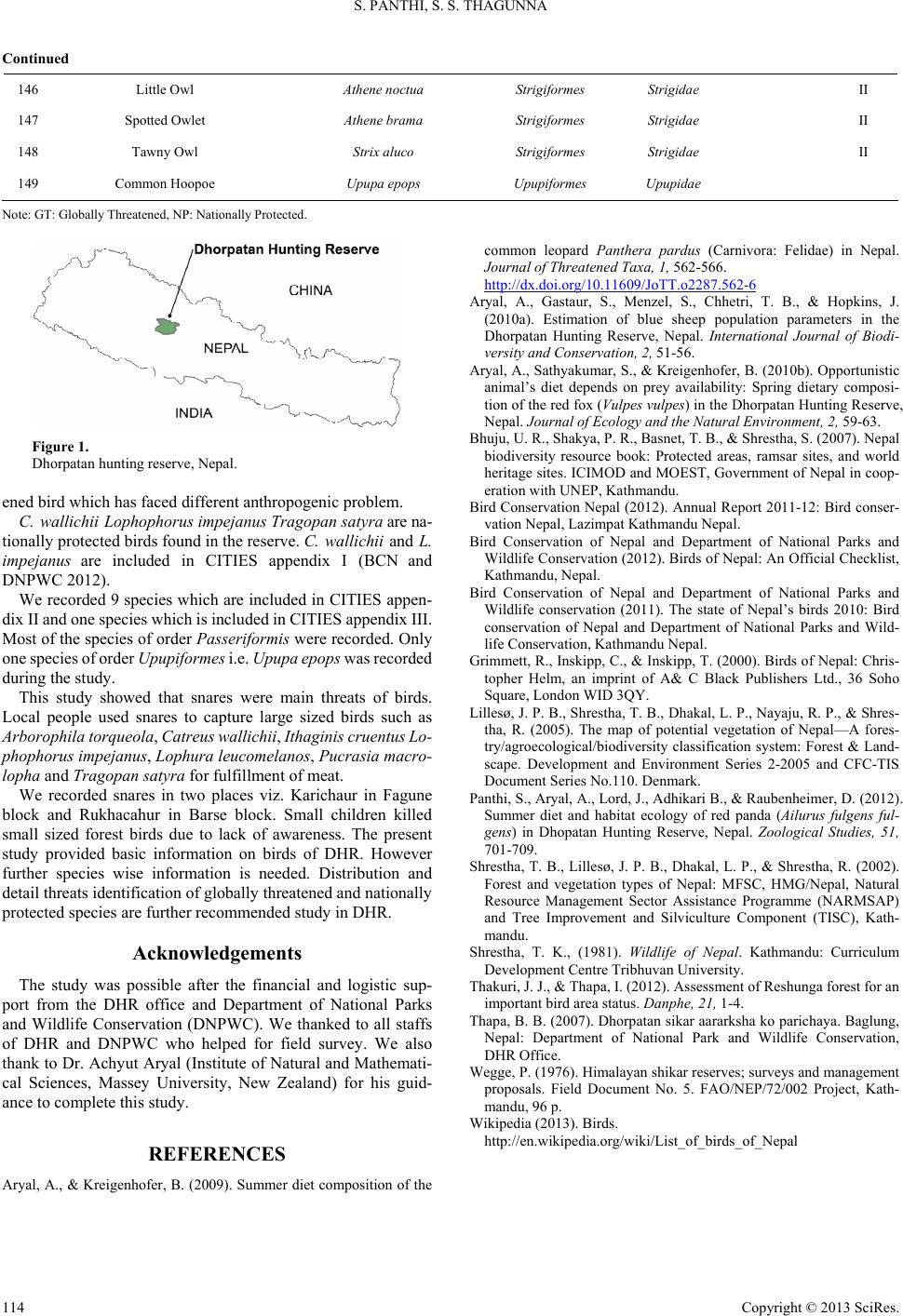
S. PANTHI, S. S. THAGUNNA
Copyright © 2013 SciRes.
114
Continued
146 Little Owl Athene noctua Strigiformes Strigidae II
147 Spotted Owlet Athene brama Strigiformes Strigidae II
148 Tawny Owl Strix aluco Strigiformes Strigidae II
149 Common Hoopoe Upupa epops Upupiformes Upupidae
Note: GT: Globally Threatened, NP: Nationally Protected.
Figure 1.
Dhorpatan hunting reserve, Nepal.
ened bird which has faced different anthropogenic problem.
C. wallichii Lophophorus impejanus Tragopan satyra are na-
tionally protected birds found in the reserve. C. wallichii and L.
impejanus are included in CITIES appendix I (BCN and
DNPWC 2012).
We recorded 9 species which are included in CITIES appen-
dix II and on e sp e cies w hich is in clude d in CIT I ES app end ix I II .
Most of the species of order Passeriformis were recorded. Only
one species of order Upupiformes i.e. Upupa epop s was recorded
during the study.
This study showed that snares were main threats of birds.
Local people used snares to capture large sized birds such as
Arborophila torqueola, Catreus wallich ii, Ithaginis cruentus Lo-
phophorus impejanus, Lophura leucomelanos, Pucrasia macro-
lopha and Tragopan satyra for fulfillment of meat.
We recorded snares in two places viz. Karichaur in Fagune
block and Rukhacahur in Barse block. Small children killed
small sized forest birds due to lack of awareness. The present
study provided basic information on birds of DHR. However
further species wise information is needed. Distribution and
detail threats identificat io n o f globally threatened and nationally
protected species are further recommended study in DHR.
Acknowledgements
The study was possible after the financial and logistic sup-
port from the DHR office and Department of National Parks
and Wildlife Conservation (DNPWC). We thanked to all staffs
of DHR and DNPWC who helped for field survey. We also
thank to Dr. Achyut Aryal (Institute of Natural and Mathemati-
cal Sciences, Massey University, New Zealand) for his guid-
ance to complete this study.
REFERENCES
Aryal, A., & Kreigenhofer, B. (2009). Summer diet composition of the
common leopard Panthera pardus (Carnivora: Felidae) in Nepal.
Journal of Threatened Taxa, 1, 562-566.
http://dx.doi.org/10.11609/JoTT.o2287.562-6
Aryal, A., Gastaur, S., Menzel, S., Chhetri, T. B., & Hopkins, J.
(2010a). Estimation of blue sheep population parameters in the
Dhorpatan Hunting Reserve, Nepal. International Journal of Biodi-
versity and Conservation, 2, 51-56.
Aryal, A., Sathyakumar, S., & Kreigenhofer, B. (2010b). Opportunistic
animal’s diet depends on prey availability: Spring dietary composi-
tion of the red fox (Vulpes vulpes) in the Dhorpatan Hunting Reserve,
Nepal. Journal of Ecology and the Natural Environment, 2, 59-63.
Bhuju, U. R., Shakya, P. R., Basnet, T. B., & Shrestha, S. (2007). Nepal
biodiversity resource book: Protected areas, ramsar sites, and world
heritage sites. ICIMOD and MOEST, Government of Nepal in coop-
eration with UNEP, Kathmandu.
Bird Conservation Nepal (2012). Annual Report 2011-12: Bird conser-
vation Nepal, Lazimpat Kathmandu Nepal .
Bird Conservation of Nepal and Department of National Parks and
Wildlife Conservation (2012). Birds of Nepal: An Official Checklist,
Kathmandu, Nepal.
Bird Conservation of Nepal and Department of National Parks and
Wildlife conservation (2011). The state of Nepal’s birds 2010: Bird
conservation of Nepal and Department of National Parks and Wild-
life Conservation, Kathmandu Nepal.
Grimmett, R., Inskipp, C., & Inskipp, T. (2000). Birds of Nepal: Chris-
topher Helm, an imprint of A& C Black Publishers Ltd., 36 Soho
Square, London WID 3QY.
Lillesø, J. P. B., Shrestha, T. B ., Dhakal, L. P., Na yaju, R. P., & Shres -
tha, R. (2005). The map of potential vegetation of Nepal—A fores-
try/agroecological/biodiversity classification system: Forest & Land-
scape. Development and Environment Series 2-2005 and CFC-TIS
Document Series No.110. Denmark.
Panthi, S., Aryal, A., Lord, J., Adhikari B., & Raubenheimer, D. (2012).
Summer diet and habitat ecology of red panda (Ailurus fulgens ful-
gens) in Dhopatan Hunting Reserve, Nepal. Zoological Studies, 51,
701-709.
Shrestha, T. B., Lillesø, J. P. B., Dhakal, L. P., & Shrestha, R. (2002).
Forest and vegetation types of Nepal: MFSC, HMG/Nepal, Natural
Resource Management Sector Assistance Programme (NARMSAP)
and Tree Improvement and Silviculture Component (TISC), Kath-
mandu.
Shrestha, T. K., (1981). Wildlife of Nepal. Kathmandu: Curriculum
Development Centre Tribhuvan University.
Thakuri, J. J., & Thapa, I. (2012). Assessment of Reshunga forest for an
important bird a rea stat us. Danphe, 21, 1-4.
Thapa, B. B. (2007). Dhorpatan sikar aararksha ko parichaya. Baglung,
Nepal: Department of National Park and Wildlife Conservation,
DHR Office.
Wegge, P. (1976). Himalayan shikar reserves; surveys and management
proposals. Field Document No. 5. FAO/NEP/72/002 Project, Kath-
mandu, 96 p.
Wikipedia (2013). Birds.
http://en.wikipedia.org/wiki/List_of_birds_of_Nepal